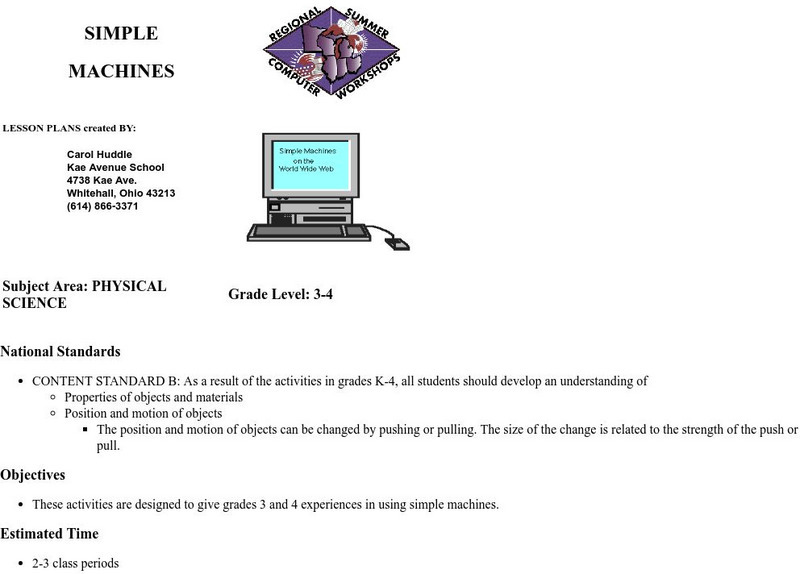Curated OER
Applied Science - Technology (2A) Lab
Second graders experiment with simple machines. In this machine lesson, 2nd graders go to different labs to see examples of a lever, inclined plane, wedge, pulley, gears, and wheel and axle. They discuss how a machine makes work a lot...
Curated OER
Simple Machines - Graphics, Experiments, Animation
Twelfth graders display simple machines through the use of graphics, experiments, and animation. They apply problem solving and design and skills.
Curated OER
Stop Pulling My Bot Around!
Students investigate the relationship between work and mechanical advantage. In this physics lesson, students calculate the work and efficiency of pulleys. They identify the different types of pulleys.
Curated OER
Move It!
Third graders examine simple machines. For this simple machines lesson, 3rd graders observe simple machines at work in a video, then experiment with creating their own simple machines to move objects.
Curated OER
Simple Machines
Fourth graders choose a simple machine and write about they way they believe it will work. Students experiment, write down procedures used and record observations. They will find a picture of the machine and add it to their report.
PBS
Blow the Roof Off!
Blow the minds of young scientists with this collection of inquiry-based investigations. Based on a series of eight videos, these "hands-on, minds-on" science lessons engage young learners in exploring a wide range of topics...
Chandler Unified School District
Art Masterpiece—Leonardo da Vinci Inventions
After getting to know the inventor, Leonardo da Vinci and his many inventions, scholars think up their own invention. Following a written description and a hand-drawn picture, learners use a method of mirror writing and antiquing to give...
Curated OER
Simply Unique
Students identify, compare and contrast simple machines and their functions. They work together in groups to complete experiments using the simple machines. They write in their journals to reflect on the lesson.
Curated OER
Break It Down!
Students explore the everyday implications of system failure. They are challenged to identify the causes of system failure.
Curated OER
Van de Graaff Generator
Students explore static electricity using the Van de Graaff generator. In this physics lesson, students construct their own Van de Graaff using simple materials. They explain how charges accumulate on this device.
Curated OER
Wheels and Axles 1
Students investigate how and why wheels are used in different types of machines. They work in teams trying to move a heavy box with and without dowels and discuss which way is easier to move the box. Next, they conduct an experiment...
Curated OER
Exploring the Properties of Matter in the Preschool
Students study the properties of the physical and natural world. In this properties of the physical and natural world lesson, preschool students work at discovery tables to see how simple machines work, what happens when items are put...
Museum of Science
Gadget Anatomy: Understanding Machines
Students observe a machine closely from several angles while it operates. Identify the elements of machines combined in different gadgets. Create a clear diagram of how a machine works.
Curated OER
Construction Worker Book
Students examine simple tools that are used in everyday life. In this construction worker tools instructional activity, students decide which tools should be used to solve the construction worker's problems in a manner that demonstrates...
Curated OER
We Have Work To Do - Science
Students begin to think of ways to make work easier. They will focus on ways to extend their abilities to lift heavy things. They will identify levers, pulleys, and inclined planes through the examination of concrete objects and hands on...
Curated OER
What Can You Make of It?
Students investigate the various uses of a paper cup. In this scientific inquiry instructional activity, students investigate various ways to use a paper cup by identifying its characteristics. Students sketch their discovery.
TeachEngineering
Teach Engineering: Simple Machines From Pyramids to Skyscrapers
Simple machines are devices with few or no moving parts that make work easier, and which people have used to provide mechanical advantage for thousands of years. Students learn about the wedge, wheel and axle, lever, inclined plane,...
Alabama Learning Exchange
Alex: Simple Machines
During this lesson, young scholars learn about the six types of simple machines. They define each type of machine, experiment with each type, utilize the Internet to explore each type of machine and build their own simple machine. This...
The Franklin Institute
Franklin Institute Online: The Pulley
This site provides an easy to understand experiment that will demonstrate the pulley to students in grades K-3. It requires only everyday materials. The students are encouraged to discover some of these concepts for themselves and apply...
NASA
Nasa: Simple Machines
A lesson plan site that contains activities designed to give grades 3 and 4 experiences in using simple machines.
TeachEngineering
Teach Engineering: Machines and Tools, Part Ii
In this activity, students gain first-hand experience with the mechanical advantage of pulleys. Students are given the challenge of helping save a whale by moving it from an aquarium back to its natural habitat into the ocean. They set...
Walter Fendt
Walter Fendt: Apps Zur Physik
This site, in German, offers numerous apps that illustrate common physics principles. Apps are organized into categories: mechanics, oscillations and waves, electrodynamics, optics, thermodynamics, the theory of relativity, physics of...




















